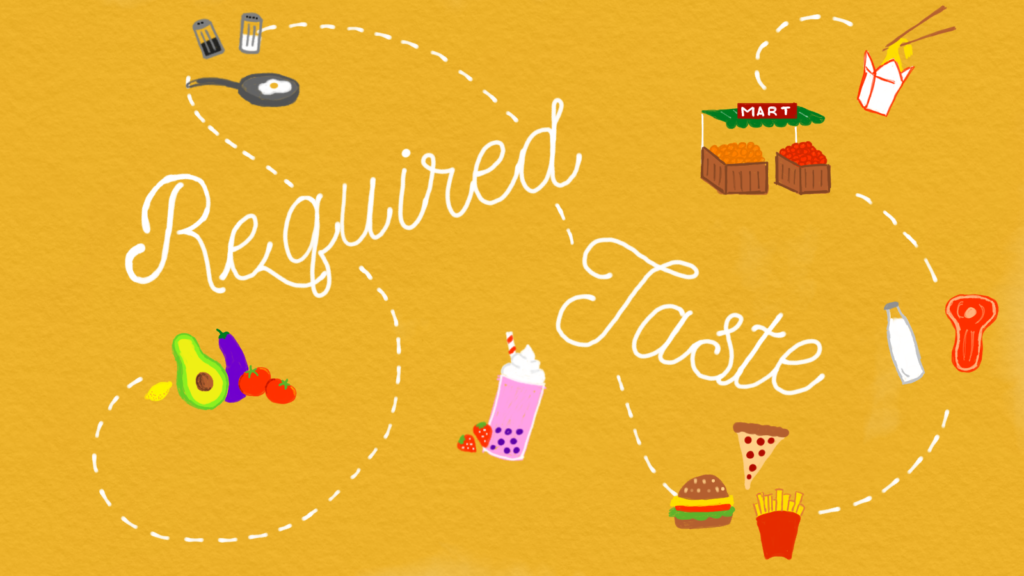Comfort food could have origins beyond simple cravings. Professor Janet Tomiyama said our desire for feel-good snacks has evolutionary roots. (Ashley Kenney/Assistant Photo editor)

Food has become more than just fuel – alongside nourishing our bodies, it taps into our emotions and can infiltrate our minds. In a country known for its freedom, columnist Zinnia Finn will explore the extent to which American culture is tethered to food and the depths to which we each experience this relationship in everyday life.
It’s midterms season and midnight – otherwise known as snack time.
The cupboard is fully stocked, but without question the half-empty package of cookies beats out its competition. Crumbs litter the inner tray, indicating a nightly pattern of snacking. In the moment, the cookies themselves appear to be the likely cravings culprits, but Janet Tomiyama, professor of health psychology at UCLA, said the root of this desire is prehistoric. Particularly in a stressful environment like college, the most appealing snack, evolutionarily speaking, is the one highest in calories and quick-acting energy. For our Neanderthal ancestors, these immediate fuel sources used to be clusters of blackberries – ripe and sweet – but she said our modern-day berry bush might look more like a 7-Eleven bursting with Snickers bars.
“In our hunter-gatherer days, most of the stress we encountered was in the form of physical stressors,” Tomiyama said. “If a cheetah was chasing you, a huge amount of energy was needed to fight or flee – that’s why we reached for food.”
Even though current stressors such as studying for an exam or worrying about COVID-19 occur in a much safer and sedentary position, the Darwinian urge to snack is still prominent, Tomiyama said. After all, it is hardwired for our survival.
However, the foods we crave aren’t solely based on their levels of fats and sugars. When offered options, it has been proven that people typically reach for what they eat the most often, Tomiyama said. On a global scale, she said culture can be a reliable indicator of taste, simply because our palette is shaped by the diet we are raised on.
This defining role of culture can be confirmed by Prince Emanuele Filiberto di Savoia, grandson of Umberto II, the last reigning king of Italy. His great-grandmother was Queen Margherita of Savoy – the namesake of Margherita pizza – so di Savoia said an affinity for Italian cuisine runs in his blood.
While visiting Los Angeles in 2016, di Savoia stumbled upon the city’s food truck scene. Fascinated by this phenomenon, which had yet to gain popularity in Europe, he wandered the maze of mobile restaurants to quench a singular craving – pasta.
Unfortunately, the LA food trucks didn’t quite deliver. Yet, this disappointment spurred innovation, di Sovia said, inspiring him to bring the best of Italy to the streets of America through his own truck, the Prince of Venice. After years on wheels, the restaurant is planning to debut a brick-and-mortar location in Westwood, where di Sovia will offer Bruins the little slice of home he feels only pasta can provide.
“I want (the customers) to enjoy, and for a moment, feel like they are in Italy,” di Savoia said. “I think food has the power to transport you to other places.”
Although di Saovia ties this teleportation ability to pasta, behavioral neuroscience professor Hugh Tad Blair suggests that this “trip” to Italy is more akin to a flashback then a journey. Referred to as episodic memory, this conscious recollection of a past experience is commonly triggered by a specific scent or scents. With our noses composing a large portion of our taste perception, Blair postulates that this is why certain foods – specifically those with strong scent cues – could trigger memories of the past.
“One of the interesting things about the sense of smell, or olfaction, is that the receptors for smell send signals directly into the brain without passing through the thalamus first,” Blair said. “This can suggest a more direct connection between the olfactory senses and emotion and memory.”
Alongside the possible neural link between olfaction and memory, Tomiyama said associative learning can also play a part in cravings relative to one’s past. This concept broadly suggests that experiences and ideas reinforce one another, explaining why memory designates some foods as sources of comfort. Tomiyama said a dish a caretaker would cook after a bad day, or a childhood prized dessert, could carry emotional connotations well into adulthood.
“You come to associate these foods with feelings of nurture,” Tomiyama said. “Feelings of comfort, feelings of warmth and feelings of love.”
Now back to the cupboard.
Reaching for those cookies could stem from an innate need for fuel – satisfied only by the most calorically dense food in sight. Or maybe the crinkly packaging is reminiscent of an elementary school post-scraped-knee pick-me-up, lovingly served alongside a glass of milk. Perhaps the scent conjures up a memory of baking snickerdoodles at three in the morning, just because.
It could also be that cookies are really delicious, which Professor Tomiyama said is more than okay.
“We aren’t the only species that (eats for comfort) – rodents do it, some species of primates do it – so if you do find yourself engaging in comfort eating or stress eating, don’t give yourself too hard of a time about it,” Tomiyama said. “If everyone in the animal kingdom is doing it, they’re doing it for a reason.”
Source: Required Taste: The evolutionary basis behind our snacking habits, cravings – Daily Bruin













